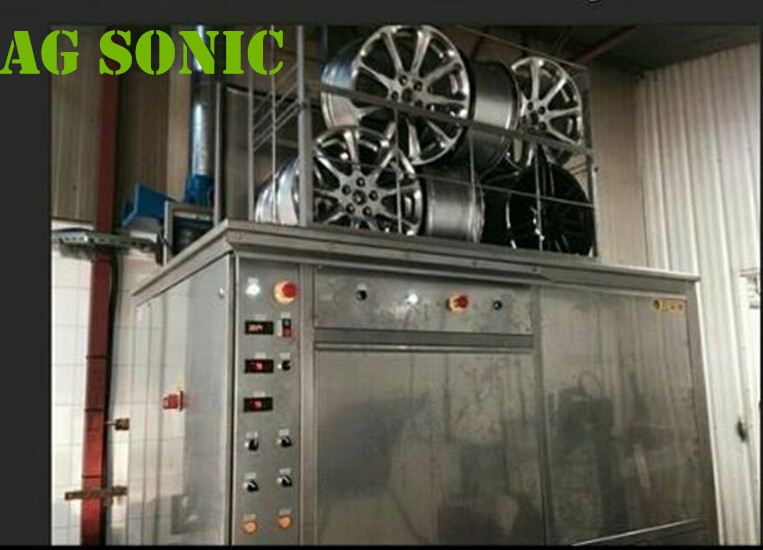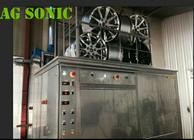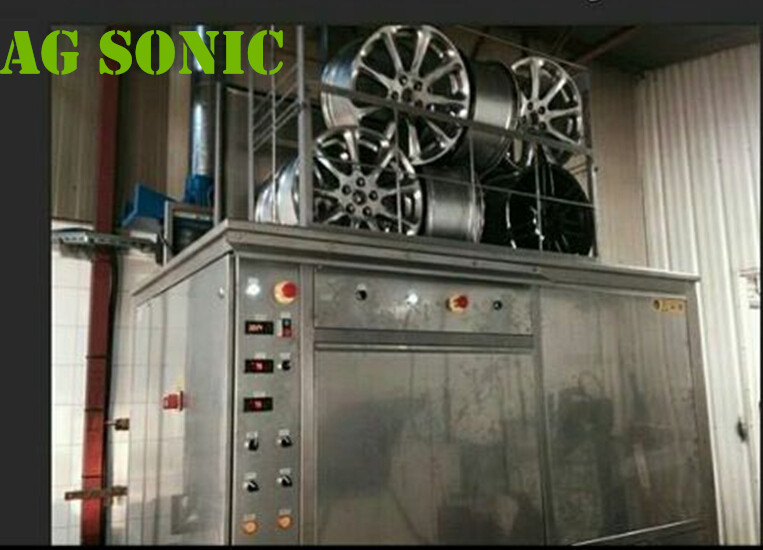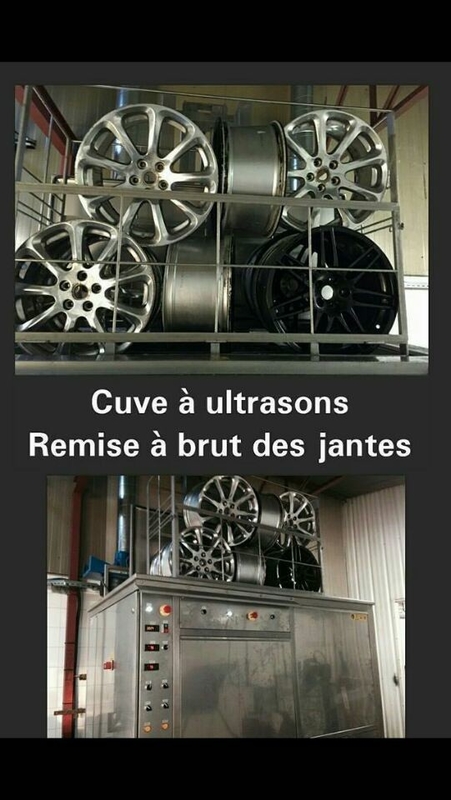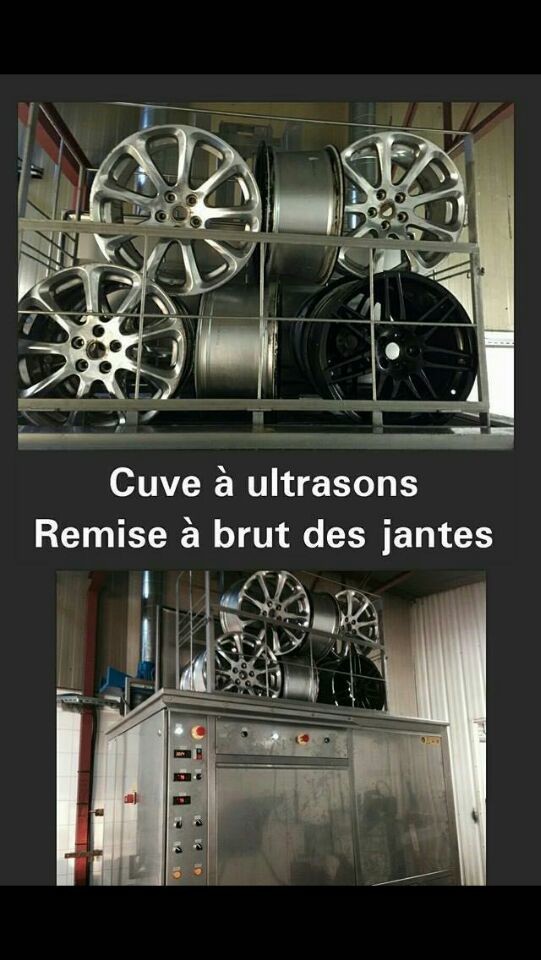Aircraft Components Ultrasonic Aircraft Wheel Cleaning Machine With Electric Lifting Tyre Cleaning Machine
When should you consider adding ultrasonics to a cleaning process?
Usually, the answer is whenever parts are not getting clean enough using the current method. Ultrasonics become a viable purchase when cleaning issues are negatively impacting productivity, quality and/or the bottom line. Effective cleaning with ultrasonics has been proven in a wide range of industries ranging from microscopic medical devices to reconditioned locomotive shafts, from aerospace parts to parts prior to coating, and more.
Ultrasonics can be included in a new cleaning process or sometimes can be retrofitted into an existing process. In many cases, rejects due to residue on parts can be virtually eliminated with the addition of ultrasonics into clean and/or rinse stations in a properly-configured parts cleaning line.
Ultrasonic Frequency and Watt Density
Ultrasonic energy occurs when sound waves are introduced into a solution such as water via a package that includes one or more ultrasonic generators and corresponding ultrasonic transducers.
The sound waves create microscopic bubbles of solution during periods of positive pressure, which implode and release a burst of energy during periods of negative pressure. This process is called cavitation. It is cavitation that enhances the separation of soils from substrates, often making ultrasonic cleaning faster, gentler, and more effective than other methods. Imploding bubbles travel wherever the solution goes, allowing cleaning activity even within complex part geometries and micro-parts.
When cleaning with ultrasonics the frequency of the sound waves is matched to the application. Frequencies range from 20 kHz to 170 kHz and above. The most commonly recommended ultrasonic frequency is 40 kHz. It is considered the “universal frequency” because it is generally safe for use in most applications and will produce the most intense cavitation energies to remove the most common types of contaminants (oil, grease, metal chips) from the widest range of substrates.
Enhance Your Cleaning Process with Ultrasonics
Ultrasonic cleaning has become increasingly popular year after year. One reason is that it's an environmentally friendly process capable of replacing some vapor degreasing processes. The second is that it enhances aqueous cleaning processes in many applications...
Ultras Wave Explanation
Pressure waves generated by high-frequency sound waves create micron-size bubbles in the aqueous cleaning solution. This bubble is shown just before implosion, which releases a tremendous amount of energy for cleaning
What can be cleaned by Ultrasonic ?
Ultrasonic cleaning involves the use of high-frequency sound waves (above the upper range of human hearing, ) to remove a variety of contaminants from parts immersed in aqueous media. The contamination can be dirt, oil, grease, buffing/polishing compounds and mold release agents, just to name a few. Materials that can be cleaned include metals, glass, ceramics and so on. Ultrasonic agitation can be used with a variety of cleaning agents.
01: Introduction for Ultrasonic cleaner
Ultrasonic cleaning is a technology that uses high frequency sound waves (ultrasonic: above the range of human hearing) to agitate an aqueous or organic medium (cleaning chemistry) that in turn acts on contaminations adhering to substrates like metals, plastics, glass, rubber and ceramics. Contaminants can be dust, dirty, oil, pigments, grease, polishing compounds, flux agents, fingerprints, soot wax and mold release agents, biological soil like blood, and so on
01: Application of indutrial ultrasonic cleaner
Ultrasonic cleaning can be used for many applications, including plastic parts, bearing, bolts, rubber parts, internal parts, plastic injection molds, transmission parts, and final cleaning of all engine parts prior to assembly, the versatility of ultrasonic cleaning machine make them the perfect choice for automotive, medical, pharmaceutical, aerospace, engineering and many other industries
Specifications Of wheel hub Tyre ultrasonic cleaner:
| Ultrasonic tank size |
| Length* width* depth |
900*560*900mm |
| Capacity |
453.6liters |
| Competitive Advantage |
With pneumatic lift |
| Generator |
3 set |
| Suitable tyre size |
Diameter:500-800 mm Witdth:135-350mm |
| Material |
Stainless steel 304/316L |
| Ultrasonic power |
4.5KW |
| Heating power |
12 KW |
| Timer |
1~30min adjustable |
| Heater |
20~80C adjustable |
| ultrasonic frequency |
28/40khz |
| voltage |
AC220/380/415V, 50/60Hz |
| casters |
4 casters with braker |
| transducer head |
90pcs |
Application:
1.Clean all types of tyre/wheel/rim
Features:
- With digital control panel-high technology ,eay to handle ,
- With Motor Rotation system –tyre and rim cab be rotated when ultrasonic cleaning
- With pneumatic chuck –can be hang on different size of car tyre
- With pneumatic lift-tyre can automatically up and down in the tank
- With Drainage-easy for waste water flow away
- With casters-easy to move
Wheel /Tyre Industrial Cleaning Machaine enough for most vertical blinds as well
2 Separate Tanks - one for cleaning and one for rinsing
3 Drain Pipes - one for each tank
4.Industrial-Grade Transducers: very reliable, efficient, and powerful
5.Durable Stainless Steel Tank
6.Digital Timer for Controlling the Ultrasonic Power
7.Temperature-Controlled Heating
8.Sturdy Casters for Easy Transporting
9.1 Year Warranty
10. ultrasonic wave generator control
RFQ OF ULTRASONIC CLEANER :
Ultrasonic Frequency and Watt Density
Ultrasonic energy occurs when sound waves are introduced into a solution such as water via a package that includes one or more ultrasonic generators and corresponding ultrasonic transducers.
The sound waves create microscopic bubbles of solution during periods of positive pressure, which implode and release a burst of energy during periods of negative pressure. This process is called cavitation. It is cavitation that enhances the separation of soils from substrates, often making ultrasonic cleaning faster, gentler, and more effective than other methods. Imploding bubbles travel wherever the solution goes, allowing cleaning activity even within complex part geometries and micro-parts.
When cleaning with ultrasonics the frequency of the sound waves is matched to the application. Frequencies range from 20 kHz to 170 kHz and above. The most commonly recommended ultrasonic frequency is 40 kHz. It is considered the “universal frequency” because it is generally safe for use in most applications and will produce the most intense cavitation energies to remove the most common types of contaminants (oil, grease, metal chips) from the widest range of substrates.



 Your message must be between 20-3,000 characters!
Your message must be between 20-3,000 characters! Please check your E-mail!
Please check your E-mail!  Your message must be between 20-3,000 characters!
Your message must be between 20-3,000 characters! Please check your E-mail!
Please check your E-mail! 
